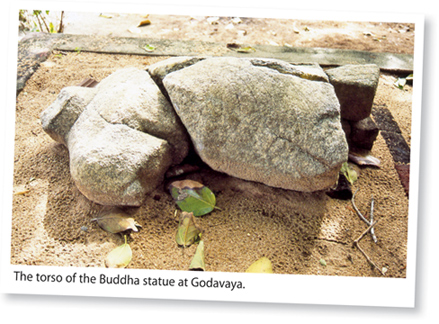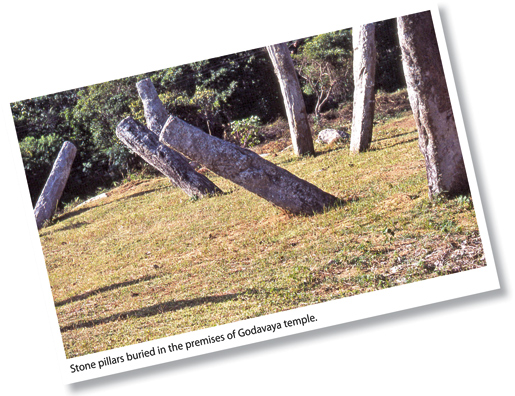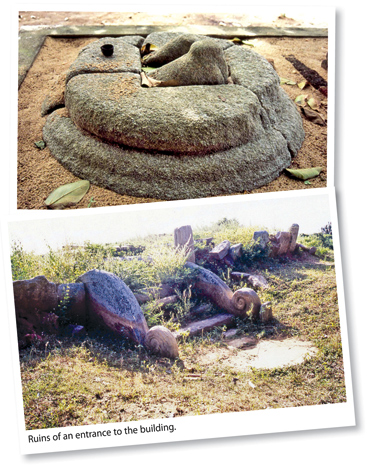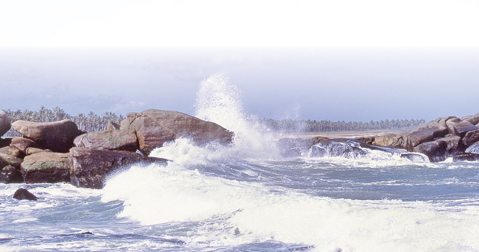|

Large boulder overlooking the seaport of Godavaya, with the
ruins of
the dwelling built by a Dutch Buddhist monk who lived there. |
Godavaya Temple:
Serinity on the Silk Route
Story and pictures by Mahil Wijesinghe
It is a placid morning and my destination is Gotha PabbathaViharaya,
better known as Godavaya temple, located on a boulder overlooking the
Indian Ocean, in the ancient sea port of Godavaya, south of the estuary
of Walawe Ganga in the Hambantota District. The view from here is
breathtaking.
Godavaya is recommended for nature lovers looking to experience
nature at its unique best. Entrance to the site is through a narrow road
bracketed with small house, in what appears to be a fishing village. The
road ends abruptly at a white sandy compound covered by huge banyan
trees.
The cooling shade provided by the thick adventitious prop roots and
arching branches give the approach to the temple proper a celestial
feel, akin to a weary traveller being welcomed with a soothing embrace.
The ancient sea port of Godavaya lies about four kilometres from
Ambalantota on the Colombo- Kataragama road. The little bay that marks
the port is now a fishing ground. Towards the west, several boulders
stand sentry against the turbulent sea, while the land behind is
littered with numerous stone ruins, including stone pillars, a stupa,
and the torso of a statue of the Buddha.
 The
recently restored stupa, lies on one rocky outcrop, giving a majestic
aura to the site. Some stone ruins, including a moonstone, stone carved
Buddha statue, broken into several parts and stone pillars have been
restored by the Department of Archaeology. The
recently restored stupa, lies on one rocky outcrop, giving a majestic
aura to the site. Some stone ruins, including a moonstone, stone carved
Buddha statue, broken into several parts and stone pillars have been
restored by the Department of Archaeology.
The inscription on a timeworn plaque outside the temple states that
all dues collected from the port were to be donated to the Godavaya
temple. It further states that King Gamini Abaya donated custom levies
of the port of Godavaya to the Viharaya.
King Gotabaya of Ruhuna
Historic records indicate that the Godavaya temple was built by King
Gotabaya of Ruhuna, in the third Century BC and that Godavaya temple
came to be called Gotha Pabbatha Raja MahaViharaya because of this
association.
According to inscriptions in the temple, this ancient site of
Godavaya had been part of the famous Silk Route, with ships anchoring
here to take precious gem stones, spices and ivory in exchange for
clothing and porcelain and other items.
The most striking feature of Godavaya is the estuary of the Walawe
Ganga, which originates in the Horton Plains, Haputale and
Kaltota-Balangoda escarpments, cascaded down the mountain slopes of
Belihul Oya, Kaltota and meanders through the Udawalawe, before finally
joining the sea at Godavaya in Ambalantota.
 The
Walawe estuary is located about 300 metres away from the site of
Godavaya. Sand dunes seal the mouth of the estuary, but the strip of
seashore that is flanked by the flowing Walawe Ganga is a fascinating
spot, with its scenic deep blue sea and landscape. The
Walawe estuary is located about 300 metres away from the site of
Godavaya. Sand dunes seal the mouth of the estuary, but the strip of
seashore that is flanked by the flowing Walawe Ganga is a fascinating
spot, with its scenic deep blue sea and landscape.
The stretch of land sandwiched between the sea shore and the bank of
the Walawe Ganga is called Diyagasgoda. The Brahmi inscription on the
rock at the site, says the old port of Godavaya was also called
Godapavita. Legends have it that the Buddha’s sacred hair relic had been
enshrined at the Godavaya temple by a Brahmin called Bhalluka.
Of times gone by
In ancient times, the Walawe basin was considered a prosperous rice
production region and the Walawe Ganga was said to have been navigable
for transportation.
It is said that the paddy harvest was transported by boats along the
Walawe Ganga, which also had a ferry service, transporting goods to be
shipped abroad from the port of Godavaya. Standing on one of the rock
boulder of the Godavaya, I looked towards the blue horizon, painting
thousands of thoughts in my mind.
 It
was easy to imagine the bustling port of Godavaya of times gone by, when
ancient ships with Arab merchants clad in white robes and turbans
transacted with local traders. But now, only silence regains with the
stone ruins as witness to history. Today’s visitors to Godavaya will
notice a spacious cement abode built atop the rock boulder. During the
World War II, a pious Dutch Buddhist monk had lived amidst this haven of
rock boulders by the seashore of Godavaya, with a fascinating view of
the deep blue sea. It
was easy to imagine the bustling port of Godavaya of times gone by, when
ancient ships with Arab merchants clad in white robes and turbans
transacted with local traders. But now, only silence regains with the
stone ruins as witness to history. Today’s visitors to Godavaya will
notice a spacious cement abode built atop the rock boulder. During the
World War II, a pious Dutch Buddhist monk had lived amidst this haven of
rock boulders by the seashore of Godavaya, with a fascinating view of
the deep blue sea.
The abode is now in ruins, but the serenity and beauty that brought
the monk to the site still prevails.
The old people living the vicinity of Godavaya recall that their
parents used to offer alms to the Dutch monk who was devout, and would
always be immersed in meditation.
The sea is very turbulent around this area.
But walking along the shore can be a beautiful experience, more so
because of the copious and different varities of sea shells to be found
here. In 2003, The Department of Archaeology, in collaboration with
researchers of Bonn University, in Germany, carried out extensive
excavations at the Godavaya temple, and found several ancient coins,
conforming that Godavaya was indeed an ancient port along the Silk
Route. It points to significant trade between foreign countries, and
also that the Kings who ruled the country at that time, had venerations
for Buddhism, paying Customs duties to the ancient Gotha
PabbathaViharaya or Godavaya temple.
|

The turbulent sea. |
|

